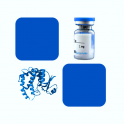
- Remove this product from my favorite's list.
- Add this product to my list of favorites.
Products
Viewed products
Newsletter
 |  |  |  |  |  |

Background
Carbonic anhydrases (CAs) are a large family of zinc metalloenzymes. CAs form a family of enzymes that catalyze the rapid interconversion of carbon dioxide and water to bicarbonate and protons (or vice versa), a reversible reaction that occurs rather slowly in the absence of a catalyst. One of the functions of the enzyme in animals is to interconvert carbon dioxide and bicarbonate to maintain acid-base balance in blood and other tissues, and to help transport carbon dioxide out of tissues. The active site of most carbonic anhydrases contains a zinc ion. There are at least five distinct CA families (α, β, γ, δ and ε). Carbonic anhydrase 9 (CA9 / CAIX) is also known as Membrane antigen MN (MN), Renal cell carcinoma-associated antigen G250, which belongs to the alpha-carbonic anhydrase family. CA9 / CAIX with an optimal activity at pH 6.49. Reversible hydration of carbon dioxide. CA IX participates in pH regulation. CA9 may be involved in the control of cell proliferation and transformation. CA-IX appears to be a novel specific biomarker for a cervical neoplasia.
Source
Recombinant Human Carbonic Anhydrase IX (38-414), His Tag (CA9-H5226) is expressed from human 293 cells (HEK293). It contains AA Gln 38 - Asp 414 (Accession # Q16790-1).
Predicted N-terminus: Gln 38
Molecular Characterization
This protein carries a polyhistidine tag at the C-terminus.
The protein has a calculated MW of 41.7 kDa. The protein migrates as 45-55 kDa under reducing (R) condition (SDS-PAGE) due to glycosylation.
Endotoxin
Less than 1.0 EU per μg by the LAL method.
Purity
>90% as determined by SDS-PAGE.
Formulation
Lyophilized from 0.22 μm filtered solution in 20 mM MES, 100 mM NaCl, pH6.5 with trehalose as protectant.
Reconstitution
Please see Certificate of Analysis for specific instructions.
For best performance, we strongly recommend you to follow the reconstitution protocol provided in the CoA.
Storage
For long term storage, the product should be stored at lyophilized state at -20°C or lower.
Please avoid repeated freeze-thaw cycles.
This product is stable after storage at:
-20°C to -70°C for 12 months in lyophilized state;
-70°C for 3 months under sterile conditions after reconstitution.
Bioactivity
Please refer to product data sheet.
(1) "Design, synthesis and in vitro evaluation of novel thiazole-coumarin hybrids as selective and potent human carbonic anhydrase IX and XII inhibitors"
Singh, Nerella, Swain et al
Int J Biol Macromol (2024)
(2) "Discovery and Mechanistic Studies of Dual-Target Hits for Carbonic Anhydrase IX and VEGFR-2 as Potential Agents for Solid Tumors: X-ray, In Vitro, In Vivo, and In Silico Investigations of Coumarin-Based Thiazoles"
Hefny, El-Moselhy, El-Din et al
J Med Chem (2024)
(3) "Re: First-in-Human Safety, Imaging, and Dosimetry of a Carbonic Anhydrase IX-Targeting Peptide, [68Ga]Ga-DPI-4452, in Patients with Clear Cell Renal Cell Carcinoma"
Thomson, Castillo, Graefen et al
Eur Urol (2024)
Showing 1-3 of 2757 papers.
Follow us